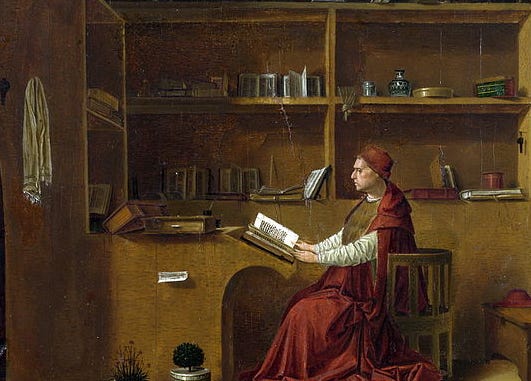We've all seen them. A book on the history of mazes, roses, chairs, or honeybees -- even anecdotes of pigments throughout history -- or, more narrowly, of how British fairy folklorists reflected the concerns of the 19th century in their fairy studies, of ginseng in Qing China, of what ancient Romans thought about birds, or of how urbanization affected American views of sincerity.
But secondary sources1 that focus on odd corners of history, or even an era -- even those you think have nothing to do with your story -- may shed unexpected light on life.
For one thing, overviews of the era in a region have to generalize. It's the nature of the beast, especially if you are dealing with the 19th century, say, or worse, the middle ages. This smooths out the roughness and craggy corners that are the chief source of vivid local color.
Odd subjects tend to turn up a lot of roughness. Including things you would never have guessed from the subject matter. In a book on French country houses, I read of private justice in pre-Revolutionary France -- where a lord might have right to low, middle, or high justice depending on what punishments he could inflict.
Some subjects are, it turns out, intertwined with other subjects. The history of pigments turns up a lot of details on poisons, because a lot of brilliant substances are also poisonous. One hypothesis about the garments that killed the person who put them on, like those Medea gave Jason's new bride, is that this is condensed-for-drama version of clothes dyed with arsenic-based dyes. Lead was long the basis for white pigments. And many more.
Other oddments turn up. As when I was reading through a book about the Pre-Raphaelites, and ran across comments on John Everett Millais's The Order of Release. Which, when it was exhibited, got some reviews. Such as
Instead of the eye dimmed even with a tear, it looks defiance, as if she had contested at some previous time the matter with the jailer, and looks a triumph, as much as to say, "I've won, and so pay me." Instead of tenderness, she is the hardest looking creature you can imagine. . . . And a friend of ours said aloud, "I would rather remain in prison all my life, or even be hanged, than go out of prison to live with that woman;
and
The subject is simply that of a wife, with child in her arms, coming with an order of release for her husband, who has been taken in the Civil Wars. The husband, overcome with emotions, and weak from a recent wound (his arm is in a sling), can but fall upon her neck and weep; moan, "firm of purpose," sheds no tear; she has none to shed; but her eye is red and heavy with weeping and waking; and she looks at the stern and unconcerned gaoler with a proud look, expressing that she has won the reward for all her trouble past.
Hmm. Which would you think -- if you learned that women were regarded as tender, fragile, innocent creatures in this era -- would be the popular view?
Not only all the other reviewers, but the general public, agreed with the second. A few times in the past -- not even every exhibition -- they had had to put up railings at exhibitions to protect popular paintings, but this one had to have a guard.
Of course, a history of Pre-Raphaelites is not about the position of Victorian women, which gives that book an advantage. I have seen a book about Victorian women discuss the painting solely in terms of the first review here. The very fact that a book is concentrated on an issue makes its side references more useful, just as they are in primary sources.2
But as with primary source, the chief value is gleaning all sorts of knowledge. Helping see how things fit together is aided by seeing how this one thread connected all sorts of things.
And while there is always the danger of shoving the knowledge into the story where it does not fit, there is always the wonder of a story springing from an odd tidbit of knowledge.
Second-Hand Sources
Most books of history are secondary source, written by people not of the era that they write of, drawing on the sources of that era. And it can be of great use to the writer.
The Gentle Art of Reading Primary Sources
Having recommended reading primary source, I should warn that there's an art to reading primary source usefully. Lots of reading will give you practice at that, but this is to provide some pointers that will at least provide some aid at some point.







You are right about the odd little bits of history sometimes providing good ideas for stories. I remember one that pointed out that Venetian glaziers once were the only people in Europe who could make glass mirrors. It was a monopoly so fiercely defended that Venice would hire assassins to kill people who figured out how to do it.